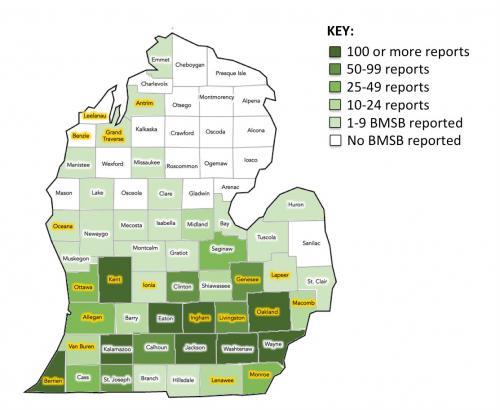Michigan brown marmorated stink bug report for Aug. 12, 2016
With first detection of brown marmorated stink bug nymphs occurring this season in southwest Michigan, fruit and vegetable growers in the southern Lower Peninsula should be scouting for nymphs.
This is the third weekly report of the Michigan State University Extension brown marmorated stink bug monitoring network. Traps were checked at 81 sites for brown marmorated stink bug nymphs and adults using pyramid or rescue-style traps baited with commercial lures. We have now caught a total of 34 brown marmorated stink bug in traps this season, the majority of which have come from six vineyards in Berrien and Van Buren counties. The rest were caught in three apple orchards (one each in Berrien, Macomb and Van Buren counties), one peach orchard (Berrien County) and at an urban site in Berrien County. This week, 2 nymphs (from a vineyard in Berrien County) and 1 adult (from an apple orchard in Van Buren) brown marmorated stink bug were caught out of the 112 traps deployed.
Growers in the southern part of the Lower Peninsula are encouraged to scout for brown marmorated stink bug – if they haven’t in the past – based on where we know it to be well-established as a nuisance pest in homes (see map). Traps are easy to deploy and check, but the area of influence for a single baited trap appears to be relatively small, so it is important to place them near the crop and to combine trapping with other sampling methods such as limb-jarring of fruit trees or sweep-netting in orchard edges close to woodlots and/or riparian areas. Visual inspection of orchard edges for the presence of fruit injury, or for the insects themselves, is recommended, especially in Berrien, Kent and Genesee counties where several commercial apple and peach orchards reported suspected damage by brown marmorated stink bug last season and where nuisance reports have been high.
Damage to fruit from brown marmorated stink bug feeding can be confused with several disease or nutrient deficiencies, depending on the particular fruit that is affected, so it is important to involve your local MSU Extension fruit educator to help determine what caused the damage or send samples to MSU Diagnostic Services.
Counties being monitored for brown marmorated stink bug in 2016 are: Allegan, Antrim, Benzie, Berrien, Genesee, Grand Traverse, Ingham, Ionia, Kent, Lapeer, Leelanau, Lenawee, Livingston, Macomb, Monroe, Oakland, Oceana, Ottawa and Van Buren. Traps are set up near apples, stone fruits (peach, plum, sweet and tart cherries), blueberries, grapes, strawberries, a variety of vegetable crops and at several urban locations considered to be hotspots.
For more information about management strategies in fruit should populations reach levels that would require control, please refer to MSU Extension Bulletin E0154, “2016 Michigan Fruit Management Guide.” To learn more about how to monitor for brown marmorated stink bugs, distinguish it from other similar-looking stink bugs and what plants it favors, visit MSU’s Brown Marmorated Stink Bug website.

A map of Michigan’s Lower Peninsula showing the extent to which brown marmorated stink bugs have become established as a nuisance pest (shaded from darkest to lightest, representing most to least nuisance reports) and the counties (highlighted in yellow) in which MSU Extension is monitoring for brown marmorated stink bugs in 2016. Reports come from those submitted by citizens to the Midwest Invasive Species Information Network since June 2016.



 Print
Print Email
Email

